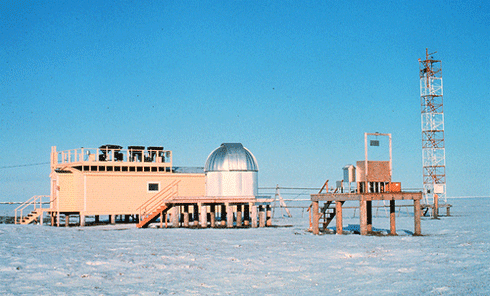
|
Published: 12 June 2012
Carbon dioxide levels reach milestone at Arctic sites
In Barrow, Alaska, the monthly average greenhouse gas measurement reached the 400 ppm mark in April – the first time this level has been reached in a remote location.

|
|
The clean air facility of the USA’s National Oceanic and Atmospheric Agency (NOAA), Point Barrow, Alaska. Credit:
NOAA. Rights: Licensed under a Creative Commons Attribution License
|
‘The northern sites in our monitoring network tell us what is coming soon to the globe as a whole,’ says Dr Pieter Tans, an atmospheric scientist with the USA’s National Oceanic and Atmospheric Agency (NOAA).
‘We will likely see global average CO2 concentrations reach 400 ppm by about 2016.’
Carbon dioxide at six other remote northern sites in NOAA’s international cooperative air sampling network also reached 400 ppm at least once this season: at a second site in Alaska and others in Canada, Iceland, Finland, Norway, and an island in the North Pacific.
Measurements at all those remote sites reflect background levels of CO2, influenced by long-term human emissions around the world, but not directly by emissions from a nearby population center. At other more locally influenced sites in NOAA’s network, such as Cape May, New Jersey, upwind cities influence CO2 concentrations, which have exceeded 400 ppm in spring for several years.
Average global levels of CO2 were 390.4 ppm in 2011, according to NOAA measurements, and will likely reach 400 ppm about 2016. Before the Industrial Revolution of the 1880s, global average CO2 was about 280 ppm.
The remote, high latitude northern sites reached 400 ppm first in April and May, the peak of the natural CO2 cycle. Plant growth cycles remove the gas from the air during late spring and summer and add it back during fall, winter and early spring. This annual cycle is largest at Northern high latitudes. During June through August, CO2 will fall again, and next April and May it is expected be to 402 ppm or higher at the same northern sites.
The concentration of atmospheric CO2 has increased every year since 1959, when David Keeling of the Scripps Institution of Oceanography made the first accurate measurements of CO2 in the atmosphere.
In the early 1960s, it rose about 0.7 ppm per year. For the last decade, it has been rising at about 2 ppm per year. That observed increase, independent of the seasonal ups and downs described above, is due to the accelerating pace of emissions from human activities, particularly the burning of fossil fuels.
‘This spring’s numbers are technically “preliminary,” and will not be finalized until next year, but rarely change more than 0.2 ppm [from preliminary numbers],’ says Dr Tans.
Source: NOAA



